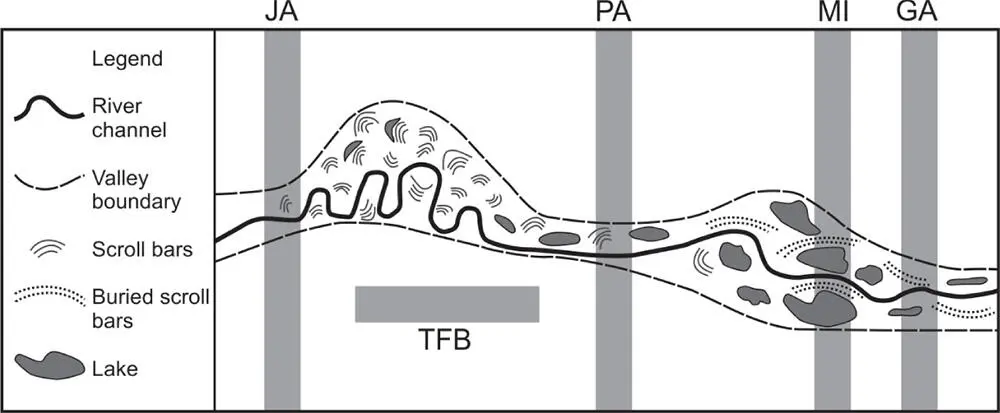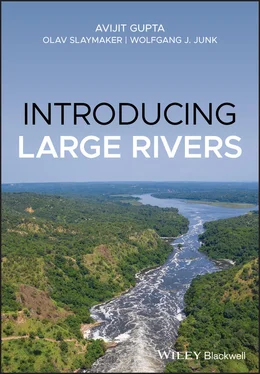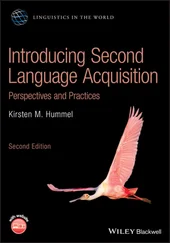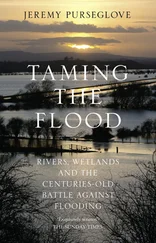2.2 The Geological Framework: Elevated Land and a Large Catchment
Many of the existing large rivers start at an elevated orogenic zone, drain a subcontinental-scale area, and flow to the ocean through a major delta. The orogeny is usually created by convergence of two tectonic plates. The course of the river may be determined by a large-scale geofracture which it follows, and its mouth may be positioned by a rock basin at the trailing margin of one of the plates. The Amazon is an excellent example. Another example is that of the present Lower Mississippi, still located over a Cretaceous sub-surface rock embayment near its present confluence with the Ohio. It has been suggested that this embayment underneath the sediment of the river is related to a reactivated rift whose history may have started much earlier in the late Precambrian (Ervin and McGinnis 1975; Potter 1978; Knox 2007).
An uplifted zone, often formed by plate collisions, and an adjoining uplifted sub-continental-scale catchment area are the necessary requirements for a major river (Tandon and Sinha 2007). These conditions exist for a time long enough to create and sustain the river system. The present continental land masses are large enough to support the current big rivers, but the size of the land masses has not always been the same. An existing drainage can be modified over time due to changes in tectonic, geomorphic, and hydrologic systems. Rivers larger than those of the present time probably existed during the supercontinents of the Wilson cycle (Pangea and Rhodinia). In contrast, very early rivers on Earth probably did not become large due to limited hydrologic support and restricted basin area on land (Potter 1978). Tectonic movements and the following geomorphic processes determine the required development of the basin topography marked by elevated boundaries and a regional slope. Continental plate tectonics determine the basin framework and trough of the river, and regional disruptions vary its character, locally.
On fewer occasions, a new topography and a confined river is created by rifting, as shown by the Rio Grande, which is a pull-apart system that began in the early Miocene and developed from separate shallow basins to an integrated system. The failed arm at a plate tectonics triple junction also may give rise to rifting which may carry a big river that occupies the long, narrow, deeply filled depression extending into a craton. At the other end of the linear depression, the river builds a delta at the plate boundary marking the edge of the continent. The Niger is an example. Another example is the Blue Nile which rises within the rift system of Ethiopia to flow through a deep gorge for about half of its length.
A new topography and a modified river may also be formed off a mantle plume (Cox 1989) when it rises to create an extensive domal surface with high elevation, as happened in several parts of the Earth during the Late Cretaceous. Certain areas were uplifted by doming and magmatic underplating, giving rise to topographic highs and new drainage systems. The Orange and part of the Zambezi River are examples.
Not all large rivers fall into such clearly generalised classes. Some do not rise from currently active orogenic belts but drain parts of old mountains that have some elevation or are only slightly active tectonically. Tandon and Sinha (2007) described such rivers as located in cratonic settings as these drain major cratons. Examples of this type are the Mississippi, Yukon, Yenisei, Lena, and Ob. Potter (1978) stated that four major morphological patterns may cover the majority of large rivers. These can be described as:
1 (1) Most sediment derived from mountains marginal to a large craton (the Amazon).
2 (2) The river flowing marginal and parallel to a fold belt (the Ganga).
3 (3) A big river flowing along the strike of a mountain range (the Mekong).
4 (4) A river superimposed across multiple mountain chains (the Danube).
Potter proposed a fifth possibility which may have occurred in the past: a river on a large craton without bordering mountains (Potter 1978).
2.3 Smaller Tectonic Movements
The basin and the channel of a big river are further modified by smaller tectonic disturbances. For example, the Lower Amazon crosses several transverse structures in its course ( Figure 2.1). In the downstream direction these are the Iquitos Arch, Jutai Arch, Purus Arch, Mont Alegre Intrusion and Ridge, and Gurupa Arch. When the Amazon crosses such structural highs, certain geomorphic features characterise the river (Mertes and Dunne 2007). The channel runs straight, its floodplain remains relatively narrow, scroll bars are found only near channel margins, and migration of the channel is limited. In contrast, wide floodplains with significant river movement, scroll bars and anabranches distinguish the river flowing on a low gradient between the upwarps. Even when covered by an alluvial fill, these upwarps affect the river. The morphology of a large river therefore varies along its course.
Large-scale fractures also regionally affect the tributary network in the Amazon Basin. Deep-seated basement fracturing appears to have disturbed the overlying sedimentary rocks that affect the drainage net, oriented in northeast and northwest directions (Potter 1978, Figure 8 and references therein; Mertes and Dunne 2007). The alignment of the Lower Negro, one of the major north bank tributaries of the Amazon, has been interpreted as controlled by a NW-SE tectonic lineament (Franzinelli and Igreja 2002). Here sunken crustal blocks and depressions occur along a half-graben, submerged to approximately 20 m with a width of up to 20 km. This controls the pattern of river islands, bars, and the location of sediment storage in the river.

Figure 2.1 Schematic illustration of the relation between structure and morphology, the Lower Amazon Valley. The vertical bars show the approximate location of arches and a tilted block which are structural highs: JA, Jutai Arch; PA, Purus Arch; MI, Monte Allegro Intrusion and Ridge; GA, Gurupa Arch; TFB, approximate location of a tilted fault block.
Source: Mertes and Dunne 2007 and references therein.

Figure 2.2 Longitudinal profile of the Nile over varying regional structures and lithology.
Source: Woodward et al. 2007, from Said 1994.
A number of rivers flow along the structural grains of a folded mountain belt almost to their mouths. The Mekong and Salween are good examples. The Mekong flows for about 80% of its length in a narrow valley flanked by ridges ( Figure 1.2a) whereas the Salween flows through a series of gorges. The lower Irrawaddy crosses three gorges in rock separated by wider basins in alluvium, and the morphology and behaviour of the river change between the gorges and basins. The entry and exit to the gorges show adjustment of the river over a short distance. The Irrawaddy finally continues through a flat lowland, discharging into the Gulf of Martaban through a large delta. The entire river is thus a sum of its different parts. The morphology and structural underpinning of large rivers are further discussed in Chapter 4.
Large rivers differ in their form and function, and for many rivers the understanding of such differences is achieved via a history of continental plate tectonics and lesser tectonic movements. The longitudinal profile of large rivers generally reflects a combination of their tectonic settings, basin lithology, and erosional history as their gradient changes ( Figure 2.2). The profile of a large river over a long distance thus may be a combination of different sections. Geological structure and lithology tend to control the basic characteristics of the rivers.
Читать дальше














